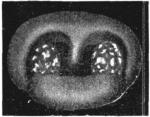Synonym.—Lacunar Tonsillitis.
Definition.—An inflammation of the mucous membrane covering the tonsils and lining the crypts or follicles of the gland.
Etiology.—This occurs most frequently between the ages of ten and twenty-five, while it is rare in infants and after middle life. Exposure to wet and cold, especially after overheating or undue use of the voice, is a common exciting cause. It occurs most frequently in the spring. Bad hygienic surroundings, especially where the sewerage is defective, allowing the escape of sewer-gas, is also thought to be a fruitful cause. An effort has been made, with some success, to show that there is some relation existing between rheumatism and this disease.
Measles, scarlet fever, and diphtheria, of the infectious fevers, play some part as a causal factor in this lesion.
Pathology.—The lacunae are filled with a cheesy substance, consisting of epithelial cells and various micrococci, and, protruding from the crypts, give the tonsil a spotted appearance; the mucous membrane between the crypts is bright red, and bathed with a creamy pus, sometimes resembling a membrane, and may be mistaken for diphtheria, though the ease with which it may be wiped off should allay all doubts as to its character. Sometimes calcareous degeneration occurs, and limy or chalky deposits fill the lacunae.
Symptoms.—This is more severe than the catarrhal form, and is usually ushered in with a chill, followed by rather a high grade of fever considering the local character of the disease. During the initiatory stage the patient complains of aching all over the body, and one who is subject to the disease will diagnose his own case before there is much local trouble.
The throat soon becomes sore and stiff, the pain extending to the ear; the tonsil or tonsils are red, angry-looking, with yellowish spots, the cheesy exudate showing from the crypt. Swallowing is difficult, and respiration is more or less impaired; the lymphatics are generally involved. The tongue is coated with a dirty fur, the breath is offensive, and the secretions markedly arrested, the skin being dry, urine scanty, and bowels constipated; the temperature frequently reaches 103° or 104°. The disease reaches its height by the fourth or fifth day, then gradually declines, the patient being convalescent by the end of the second week.
Diagnosis.—Remembering the. chief characteristics of this form of the disease, the diagnosis is readily made; the active fever, the characteristic aching of the whole body, the cheesy cxudate filling the lacunae, and the creamy exudate that can be readily wiped off without causing bleeding, enables us to recognize this from diphtheria,, the only disease that it resembles.
 The clinical picture is a surer guide than the Klebs-Loemer bacillus, as it is well known that this germ may reside in other than diphtheretic throats.
The clinical picture is a surer guide than the Klebs-Loemer bacillus, as it is well known that this germ may reside in other than diphtheretic throats.
Prognosis.—The prognosis is favorable, the disease rapidly yielding to specific treatment in from three to five days.
Treatment.—But few remedies are needed; aconite, phytolacca, belladonna, macrotys, gelsemium, and guaiac will meet all the conditions present.
Where the surface presents an angry appearance, and is red, dry, and hot,—
| Aconite | 5 drops. |
| Belladonna | 8-10 drops. |
| Water | 4 ounces. M. |
| Sig. Teaspoonful every hour will give relief. | |
Where the throat is painful and the lymphatics are enlarged, nothing is better than aconite and phytolacca, a half a dram of the latter replacing the belladonna in the former prescription. My colleague. Dr. Watkins, could hardly treat this disease without using tincture guaiac, and, having used it recently, I am ready to give it a hearty sanction. For the general aching and soreness and stiffness of the neck, gelsemium and macrotys a half dram, to four ounces of water, will give speedy relief. The use of potassium chlorate as a gargle, and the cold wet pack, will be the only local treatment necessary.
The Eclectic Practice of Medicine, 1907, was written by Rolla L. Thomas, M. S., M. D.

